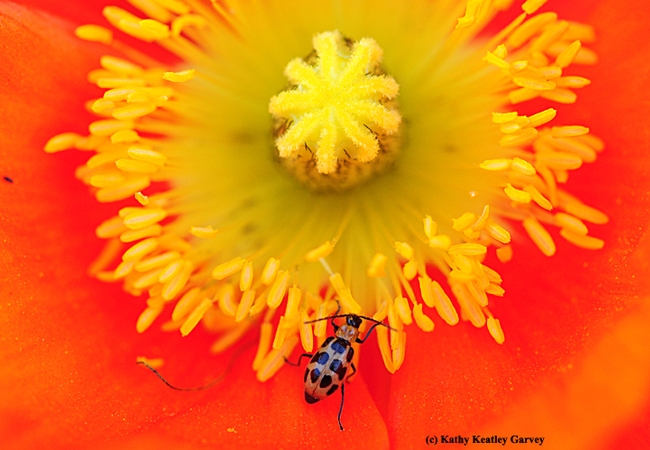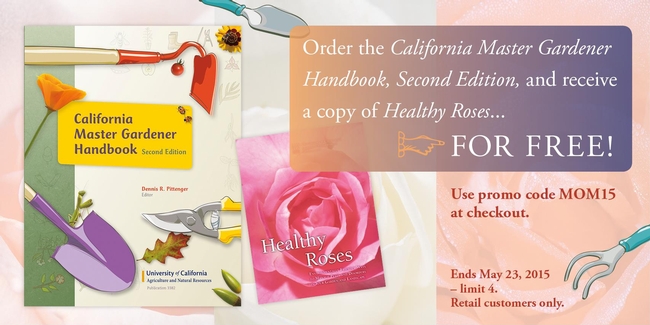From the UC Blogosphere...
A Case of Mistaken Identity
"Ah, look at that cute little yellow ladybug! Isn't it pretty?" How many times have you heard that? Often it is not the...

A spotted cucumber beetle foraging on Iceland poppy. (Photo by Kathy Keatley Garvey)
Recycled irrigation water raises food safety questions
"Everyone smells the petrochemicals in the irrigation water," said Blake Sanden, UC Agriculture and Natural Resources Cooperative Extension advisor in Kern County. "When I talk to growers, and they smell the oil field crap in that water, they assume the soil is taking care of this."
The farmers trust that organisms in the soil remove toxins or impurities in the water. However, the trust may be misplaced.
Microoganisms in soils can consume and process some impurities, Sanden said, but it's not clear whether oil field waste is making its way into the roots or leaves of irrigated plants, and then into the food chain.
It's unlikely that petrochemicals will show up in an almond, for example, he said, "But can they make it into the flesh of an orange or grape? It's possible. A lot of this stuff has not been studied in a field setting or for commercial food uptake."
The reporter also spoke to Carl Winter, a UC ANR Cooperative Extension specialist based at UC Davis. He said some plants can absorb toxins without transferring them to the leaves or the flesh of their fruit.
Still, he said, "it's difficult to say anything for sure because we don't know what chemicals are in the water."
A visiting scholar at UC Berkeley who is a researcher analyzing hydraulic fracturing for the California legislature said the issue is "one of the things that keeps me up at night."
"You can't find what you don't look for," he said.
Perfect Gift for Mother's Day!
Mother's Day is right around the corner (Sunday, May 10th) and we know that Mother's Day shopping can be a challenge. If your trying to think of the perfect gift for the Mom in your life why not buy her the CA Master Gardener Handbook, Second Edition and you'll get a copy of Healthy Roses for FREE! Click on the link to order. http://
UC CalFresh positioned to battle childhood obesity
The University of California Agriculture and Natural Resources (UC ANR) nutrition education program, UC CalFresh, was featured in the last installment of a four-week wellness series in the Fresno Bee. The series covered asthma, diabetes and heart disease before tackling the issue of obesity in the story about UC CalFresh.
Reporter Barbara Anderson reported that the UC ANR Cooperative Extension CalFresh program in Fresno County reaches 75 elementary schools and 1,000 classrooms. Madera County schools will be added in October.
UC CalFresh nutrition educators present research-based curriculum and food tastings in the classrooms. Because food habits begin during childhood, they hope that by steering children to fruits, vegetables and whole grains early on, the healthy food will become part of their lifelong dietary patterns.
UC CalFresh also reaches out to adults at job training programs, senior centers and schools, the story said. UC CalFresh educator Tacu Vang presented lessons at Jobs & Beyond, teaching participants how much sugar is found in sodas and other sugary drinks. "I'm going to stay away from sugary drinks," said Juan Martinez, 35. "You can't get better than water."
The story was accompanied by a gallery of pictures showing happy children and colorful vegetables. A one-minute video that is part of the gallery starts with a UC nutrition educator leading a group of children chanting, "Fruits and vegetables give me shiny hair, smooth skin and sparkly eyes." In the video, Shelby MacNab, UC ANR Cooperative Extension nutrition program manager in Fresno County, said in addition to the nutrition education, the program also offers technical assistance to schools to create smarter lunchrooms that lead to children making smarter choices at breakfast and lunchtime.
The part of the program that targets adults aims to help parents "plan healthy meals, stretch food dollars, and make healthy choices for their families," MacNab said.
Considering Using a Drought and Foot Traffic Tolerant Grass?
Help for the Gardener from the Contra Costa Master Gardener Help Desk
Client's Request: I am looking for advice on a drought tolerant grass variety or mix for my front yard. We are located in San Ramon, and the area receives full sun. We have taken out our existing lawn! We will have edibles, water permeable surfaces, paths and a small amount of grass (or other suitable ground cover), about 200 ft2. This will be mostly ornamental, although one area (next to the driveway) will likely receive some foot traffic. I identified UC Davis Buffalo grass as a possibility, but we are open to anything that makes sense. Most important are low water requirement and low maintenance, ability to tolerate some foot traffic, open to a longer ‘shaggy' growth habit, although the ability to mow to a shorter length would be nice. Full sun environment. Soil is good I think, some clay but not too heavy, drains well.
CCMG Help Desk Response: Congratulations on taking the first step towards a water-wise garden by removing your lawn. It's important that we all learn how to use water more efficiently as demand rises and drought conditions continue. You would like to retain a small lawn which will receive foot traffic next to the driveway and would like advice on grass selection.
Before evaluating lawn alternatives, it is important to understand the differences between the two categories of grasses. Grasses are considered warm-season or cool-season, depending on when they grow best. In California warm-season grasses (e.g Bermuda, St. Augustine, buffalo) generally do best in southern California while cool-season grasses (e.g. blue, rye, fescue, bent) do best north of the Bay Area. In between is a transition zone, where both cool-season and warm-season grasses will grow but the climate is not optimum for either. Warm-season grasses tend to turn brown and go dormant during the winter in areas where there is frost, such as San Ramon. And cool season grasses require extra water to endure our hot dry summers.
Below are several options for lower water use grasses which can tolerate foot traffic. However, none of the grasses listed below currently qualify for your Water District's (EBMUD) lawn conversion rebates, nor does synthetic turf. In order to qualify for a lawn conversion rebate, EBMUD requires that the lawn be replaced with low or very low water-use plants, or permeable lawn alternatives such as decomposed granite or mulch.
Native Bentgrass - Agrostis pallens is a cool-season California native bentgrass, with a uniform growing habit, medium texture, and deep green color. Native bentgrass requires full sun, withstands foot traffic, and has a good wear recovery due to self repairing rhizomes. Native bentgrass can be either mowed or it can be left to flop, creating the look of a natural, informal meadow. If you want the look of a mowed lawn, you should continually mow it. If you let it get long and shaggy before mowing it low, it will have a scalped look until it has had time to grow back. The sod grower's irrigation trials indicate that Native Bentgrass requires about half the water of a traditional cool-season grass to keep the lawn green throughout the year. Starting a native bentgrass lawn from seed can be a challenge because it is slow to start. But it has recently been made available as sod with degradable netting from Delta Bluegrass Company in Stockton. The price of Native Bentgrass sod is more than that of traditional blue, rye, or fescue sods because it takes longer for the grower to produce. If cost is not the primary factor, a Native Bentgrass sod might make a great alternative to your conventional lawn. For more information on this California Native Sod, see http://www.deltabluegrass.com/blendcomparisonchart .
UC Verde Buffalograss - UC Verde is a variety of buffalograss which was developed by University of California researchers at Riverside and Davis as a lower water use alternative to the traditional cool and warm-season grasses. It is a warm-season grass native to the North American plains; it looks terrific during summer; and is soft on bare feet. But its main drawback is that in Northern California it goes fully dormant in the winter, turning straw-colored after a hard frost occurs. People often use a biodegradable green dye during the winter in order to maintain the appearance of a green lawn. UC Verde grows to only 4-6" tall and requires mowing only every 2-3 weeks. It is planted from plugs which are usually spaced 12 inches apart and should be planted early in the warm season (e.g. May) to give the lawn a chance to establish before the weather cools. It spreads by rhizomes and is very competitive with weeds once established. However, keeping the lawn weed-free until it becomes fully established is more challenging than installing sod, and may require an aggressive weeding campaign. UC Verde buffalograss requires 50% to 75% less water than the typical fescue lawn. For more information on growing and maintaining UC Verde buffalograss, including photos of the grass throughout the season, see http://cesacramento.ucanr.edu/Pomology/Turf_Demonstration_Project/Three_species_in_irrigation_trial/UC_Verde_buffalograss/ .
No-Mow Fineleaf Fescue – Fineleaf fescues are cool-season grasses which include red fescue, Chewings fescue, sheep fescue and hard fescue. Many new and improved fineleaf fescue species and cultivars have come to California in recent years. Fineleaf fescues can be either seeded or sodded. They typically require about 85% of the water needed to keep a typical lawn green in the summer but they can withstand more severe irrigation deficit and dormancy with the ability to come back the following year. Fineleaf fescue lawns can be kept to about 2 ½" by mowing every 2 to 3 weeks or they can be left to grow to a height of 6 to 12 inches to create a "natural" look by mowing 1 to 4 times per year. They are an aesthetically pleasing no-mow grassy groundcover, with lower water requirements, however, they are not suitable for areas where pedestrian traffic is common. For more information on fineleaf fescue, see the attached U.C. article "No-Mow Fineleaf Fescue Grasses for California Urban Landscapes" (http://anrcatalog.ucdavis.edu/pdf/8391.pdf).
Irrigation – Whichever grass you select, your irrigation system plays an important role in water conservation. Standard spray irrigation heads are not an efficient method of applying water. You might consider replacing conventional sprinkler nozzles with high-efficiency rotating or precision nozzles. Or perhaps install a below grade inline emitter system such as Eco-mat by Hunter irrigation http://www.hunterindustries.com/irrigation-product/micro-irrigation/eco-matr-and-pld-esd . Replacing traditional irrigation timers with weather-based models (smart controllers) can help to provide the amount of water actually required by the plant, and often results in water savings. If you are redoing you irrigation system, you might want to check out the water district's rebates, if any, for upgrading irrigation equipment and installing Smart Controllers (for EBMUD see http://www.ebmud.com/for-customers/water-conservation-rebates-and-services/lawn-conversion-irrigation-upgrade-rebates).
Good luck with your project. Feel free to contact us if you need additional information.
Contra Costa Master Gardeners' Help Desk
Note: The Contra Costa Master Gardener Help Desk is available year-round to answer your gardening questions. Except for a few holidays, we're open every week, Monday through Thursday for walk-ins from 9:00 am to Noon at 75 Santa Barbara Road, 2d Floor, Pleasant Hill, CA 94523. We can also be reached via telephone: (925) 646-6586, email: ccmg@ucanr.edu, or on the web at http://ccmg.ucanr.edu/Ask_Us/










